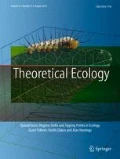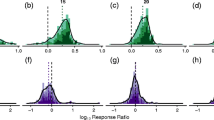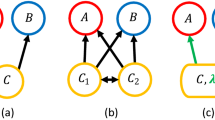Abstract
Ecological communities consist of generalists who interact with proportionally many species, and specialists who interact with proportionally few. The strength of these interactions also varies, with communities typically exhibiting a few strong links embedded within many weak links. Historically, it has been argued that generalists should interact more weakly with their partners than specialists and, since weak interactions are thought to increase community stability, that this pattern increases the stability of diverse communities. Here, we studied model-generated predator-prey communities to explicitly investigate the validity of this argument. In feasible communities—those which were both locally stable and all species had positive biomass—we indeed found that species with many predators or prey are affected by them more weakly than species with few. This relationship, however, is only part of the story. While species with many predators (or prey) tend to be only weakly affected by each of them, these many weak interactions are balanced by a few strong interactions with prey (or predators). These few strong interactions are large enough that, when the effect of predator and prey interactions are combined, it seems that species with many interactions actually interact more strongly than species with few interactions. Though past research has tended to focus on either the arrangement of species interactions or the strength of those interactions, we show here that the two are in fact inextricably linked. This observation has implications for both the realistic design of theoretical models, and the conservation of ecological communities, especially those in which the strength and arrangement of species’ interactions are impacted by biodiversity-loss disturbances such as habitat alteration.



Similar content being viewed by others
References
Allesina S, Pascual M (2008) Network structure, predator-prey modules, and stability in large food webs. Theor Ecol 1:55–64. doi:10.1007/s12080-007-0007-8
Allesina S, Tang S (2012) Stability criteria for complex ecosystems. Nature 483(7388):205–208. doi:10.1038/nature10832
Arii K, Parrott L (2004) Emergence of non-random structure in local food webs generated from randomly structured regional webs. J Theor Biol 227(3):327–333. doi:10.1016/j.jtbi.2003.11.011
Barabási AL, Albert R (1999) Emergence of scaling in random networks. Science 286(5439):509–512. doi:10.1126/science.286.5439.509
Bascompte J, Jordano P, Melián CJ, Olesen JM (2003) The nested assembly of plant-animal mutualistic networks. Proc Natl Acad Sci 100(16):9383–9387
Bernays EA, Singer MS, Rodrigues D (2004) Foraging in nature: foraging efficiency and attentiveness in caterpillars with different diet breadths. Ecol Entomol 29(4):389–397. doi:10.1111/j.0307-6946.2004.00615.x
Borrelli JJ (2015) Selection against instability: stable subgraphs are most frequent in empirical food webs. Oikos. doi:10.1111/oik.02176 10.1111/oik.c
Borrelli JJ, Ginzburg LR (2014) Why there are so few trophic levels: Selection against instability explains the pattern. Food Webs 1:10–17. doi:10.1016/j.fooweb.2014.11.002
Borrelli JJ, Allesina S, Amarasekare P, Arditi R, Chase I, Damuth J, Holt RD, Logofet DO, Novak M, Rohr RP, Rossberg AG, Spencer M, Tran JK, Ginzburg LR (2015) Selection on stability across ecological scales. Trends Ecol Evol 30(7):417–425. doi:10.1016/j.tree.2015.05.001
Brose U (2010) Improving nature conservancy strategies by ecological network theory. Basic Appl Ecol 11(1):1–5. doi:10.1016/j.baae.2009.11.003
Camacho J, Guimerà R, Nunes Amaral LA (2002) Robust patterns in food web structure. Phys Rev Lett 88(22):228,102. doi:10.1103/PhysRevLett.88.228102
Cardinale BJ, Duffy JE, Gonzalez A, Hooper DU, Perrings C, Venail P, Narwani A, Mace GM, Tilman D, Da Wardle, Kinzig AP, Daily GC, Loreau M, Grace JB, Larigauderie A, Srivastava DS, Naeem S (2012) Biodiversity loss and its impact on humanity. Nature 486(7401):59–67. doi:10.1038/nature11148
de Mazancourt C, Isbell F, Larocque A, Berendse F, De Luca E, Grace JB, Haegeman B, Wayne Polley H, Roscher C, Schmid B, Tilman D, van Ruijven J, Weigelt A, Wilsey BJ, Loreau M (2013) Predicting ecosystem stability from community composition and biodiversity. Ecol Lett 16(5):617–25. doi:10.1111/ele.12088
de Ruiter PC, Neutel AM, Moore JC (1995) Energetics, patterns of interaction strengths, and stability in real ecosystems. Science 269(5228):1257–1260
Donohue I, Petchey OL, Montoya JM, Jackson AL, McNally L, Viana M, Healy K, Lurgi M, O’Connor NE, Emmerson MC (2013) On the dimensionality of ecological stability. Ecol Lett 16(4):421–429. doi:10.1111/ele.12086
Dunne JA, Williams RJ, Martinez ND (2002) Food-web structure and network theory: the role of connectance and size. Proc Natl Acad Sci 99(20):12,917–12,922. doi:10.1073/pnas.192407699
Emmerson M, Yearsley JM (2004) Weak interactions, omnivory and emergent food-web properties. Proc R Soc B Biol Sci 271(1537):397–405. doi:10.1098/rspb.2003.2592
Estrada E (2007) Food webs robustness to biodiversity loss: the roles of connectance, expansibility and degree distribution. J Theor Biol 244(2):296–307. doi:10.1016/j.jtbi.2006.08.002
Fagan WF, Hurd LE (1994) Hatch density variation of a generalist arthropod predator: population consequences and community impact. Ecology 75(7):2022–2032
Gardner M, Ashby W (1970) Connectance of large dynamic (cybernetic) systems: critical values for stability. Nature 228(21):784
Gellner G, McCann K (2012) Reconciling the Omnivory-stability debate. Am Nat 179(1):22–37. doi:10.1086/663191
Gilpin M (1975) Stability of feasible predator-prey systems. Nature 254:137–139
Gravel D, Canard E, Guichard F, Mouquet N (2011) Persistence increases with diversity and connectance in trophic metacommunities. PLOS ONE 6(5):e19,374. doi:10.1371/journal.pone.0019374
Gunzburger MS, Travis J (2004) Evaluating predation pressure on green treefrog larvae across a habitat gradient. Oecologia 140(3):422–9. doi:10.1007/s00442-004-1610-7
Haddad NM, Crutsinger GM, Gross K, Haarstad J, Tilman D (2011) Plant diversity and the stability of foodwebs. Ecol Lett 14(1):42–6. doi:10.1111/j.1461-0248.2010.01548.x
Haydon D (1994) Pivotal assumptions determining the relationship between stability and complexity: an analytical synthesis of the stability-complexity debate. Am Nat 144(1):14. doi:10.1086/285658 10.1086/285658
Haydon DT (2000) Maximally stable model ecosystems can be highly connected. Ecology 81(9):2631–2636. doi:10.1890/0012-9658(2000)081%5B2631:MSMECB%5D2.0.CO;2
Holling C (1959) The components of predation as revealed by a study of small-mammal predation of the European pine sawfly. The Canadian Entomologist 93(5):293–320
Holyoak M, Sachdev S (1998) Omnivory and the stability of simple food webs. Oecologia 117:413–419
Ives AR, Cardinale BJ (2004) Food-web interactions govern the resistance of communities after non-random extinctions. Nature 429:174–177. doi:10.1038/nature02454.1
Ives AR, Carpenter SR (2007) Stability and diversity of ecosystems. Science 317(5834):58–62. doi:10.1126/science.1133258
James A, Pitchford JW, Plank MJ (2012) Disentangling nestedness from models of ecological complexity. Nature 487(7406):227–230. doi:10.1038/nature11214
Jansen VAA, Kokkoris GD (2003) Complexity and stability revisited. Ecol Lett 6(6):498–502. doi:10.1046/j.1461-0248.2003.00464.x
Kokkoris G, Jansen V (2002) Variability in interaction strength and implications for biodiversity. J Anim Ecol 71(2):362–371. doi:10.1046/j.1365-2656.2002.00604.x
Laska M, Wootton J (1998) Theoretical concepts and empirical approaches to measuring interaction strength. Ecology 79(2): 461–476
Law R, Morton R (1993) Alternative permanent states of ecological communities. Ecology 74(5):1347–1361
Levins R (1968) Evolution in changing environments: some theoretical explorations. Princeton University Press, Princeton
Loreau M, Mouquet N, Gonzalez A (2003) Biodiversity as spatial insurance in heterogeneous landscapes. Proc Natl Acad Sci 100(22):12,765–12,770. doi:10.1073/pnas.2235465100
MacArthur R (1955) Fluctuations of animal populations and a measure of community stability. Ecology 36(3):533–536
May R (1972) Will a large complex system be stable? Nature 238: 413–414
McCann K, Hastings A (1997) Re-evaluating the omnivory-stability relationship in food webs. Proc R Soc B Biol Sci 264(1385):1249–1254. doi:10.1098/rspb.1997.0172
McCann K, Hastings A, Huxel G (1998) Weak trophic interactions and the balance of nature. Nature 395(October):794–798
McCann KS (2000) The diversity-stability debate. Nature 405(6783):228–233. doi:10.1038/35012234
Montoya J, Solé R (2003) Topological properties of food webs: from real data to community assembly models. Oikos 102(3): 614–622
Montoya J, Emmerson M, Solé R, Woodward G (2005) Perturbations and indirect effects in complex food webs. In: de Ruiter PC, Wolters V, Moore JC (eds) Dynamic Food Webs: Multispecies assemblages, ecosystem development, and environmental change. Academic, New York, pp 369–380
Montoya JM, Woodward G, Emmerson MC, Solé RV (2009) Press perturbations and indirect effects in real food webs. Ecology 90(9):2426–2433
Mougi A, Kondoh M (2012) Diversity of interaction types and ecological community stability. Science 337(6092):349–351. doi:10.1126/science.1220529
Neutel AM, Heesterbeek JAP, De Ruiter PC (2002) Stability in real food webs: weak links in long loops. Science 296(5570):1120–3. doi:10.1126/science.1068326
O’Gorman EJ, Jacob U, Jonsson T, Emmerson MC (2010) Interaction strength, food web topology and the relative importance of species in food webs. J Anim Ecol 79(3):682–92. doi:10.1111/j.1365-2656.2009.01658.x
Otto SB, Rall BC, Brose U (2007) Allometric degree distributions facilitate food-web stability. Nature 450(7173):1226–1229. doi:10.1038/nature06359
Paine RT (1992) Food-web analysis through field measurement of per capita interaction strength. Nature 355(6355):73–75
Paterson G, Whittle DM, Drouillard KG, Haffner GD (2009) Declining lake trout (Salvelinus namaycush) energy density: are there too many salmonid predators in the Great Lakes? Can J Fish Aquat Sci 66(6):919–932. doi:10.1139/F09-048
Pereira HM, Leadley PW, Proença V, Alkemade R, Scharlemann JPW, Fernandez-Manjarrés JF, Araújo MB, Balvanera P, Biggs R, Cheung WWL, Chini L, Cooper HD, Gilman EL, Guénette S, Hurtt GC, Huntington HP, Mace GM, Oberdorff T, Revenga C, Rodrigues P, Scholes RJ, Sumaila UR, Walpole M (2010) Scenarios for global biodiversity in the 21st century. Science 330(6010):1496–1501. doi:10.1126/science.1196624
Pimm S, Lawton J (1978) On feeding on more than one trophic level. Nature 275:542–544
Pimm SL, Lawton JH (1977) Number of trophic levels in ecological communities. Nature 268:330–331
Roberts A (1974) The stability of a feasible random ecosystem. Nature 251:607–608
Rodriguez-Girones M (2012) Possible top-down control of solitary bee populations by ambush predators. Behav Ecol 23(3):559–565. doi:10.1093/beheco/arr228
Rooney N, McCann KS (2012) Integrating food web diversity, structure and stability. Trends Ecol Evol 27(1):40–6. doi:10.1016/j.tree.2011.09.001
Stouffer D, Camacho J, Guimera R, NC A, Nunes Amaral LA (2005) Quantitative patterns in the structure of model and empirical food webs. Ecology 86(5):1301–1311
Stouffer DB, Bascompte J (2010) Understanding food-web persistence from local to global scales. Ecol Lett 13(2):154–161. doi:10.1111/j.1461-0248.2009.01407.x
Stouffer DB, Bascompte J (2011) Compartmentalization increases food-web persistence. Proc Natl Acad Sci 108(9):3648–3652. doi:10.1073/pnas.1014353108
Tanabe K, Namba T (2005) Omnivory creates chaos in simple food web models. Ecology 86(12):3411–3414. doi:10.1890/05-0720 10.1890/05-0720
Terraube J, Arroyo B, Madders M, Mougeot F (2011) Diet specialisation and foraging efficiency under fluctuating vole abundance: a comparison between generalist and specialist avian predators. Oikos 120(2):234–244. doi:10.1111/j.1600-0706.2010.18554.x
Thébault E, Fontaine C (2010) Stability of ecological communities and the architecture of mutualistic and trophic networks. Science 329(5993):853–856. doi:10.1126/science.1188321
Tilman D (1996) Biodiversity: population versus ecosystem stability. Ecology 77(2):350–363
Tilman D, Downing J (1994) Biodiversity and stability in grasslands. Nature 367:363–365
Tylianakis JM, Laliberté E, Nielsen A, Bascompte J (2010) Conservation of species interaction networks. Biol Conserv 143(10): 2270–2279. doi:10.1016/j.biocon.2009.12.004
Williams RJ (2008) Effects of network and dynamical model structure on species persistence in large model food webs. Theor Ecol 1(3):141–151. doi:10.1007/s12080-008-0013-5
Williams RJ, Martinez ND (2000) Simple rules yield complex food webs. Nature 404(6774):180–183. 10.1038/35004572
Williams RJ, Martinez ND (2008) Success and its limits among structural models of complex food webs. J Anim Ecol 77(3):512–519. doi:10.1111/j.1365-2656.2008.01362.x
Wootton J (1997) Estimates and tests of per capita interaction strength: diet, abundance, and impact of intertidally foraging birds. Ecol Monogr 67(1):45–64
Wootton JT, Emmerson M (2005) Measurement of interaction strength in nature. Annu Rev Ecol Evol Syst 36(1):419–444. doi:10.1146/annurev.ecolsys.36.091704.175535
Worm B, Duffy J (2003) Biodiversity, productivity and stability in real food webs. Trends Ecol Evol 18 (12):628–632. doi:10.1016/j.tree.2003.09.003
Yamada SB, Boulding EG (1998) Claw morphology, prey size selection and foraging efficiency in generalist and specialist shell-breaking crabs. J Exp Mar Biol Ecol 220(2):191–211. doi:10.1016/S0022-0981(97)00122-6
Yodzis P (1988) The indeterminacy of ecological interactions as perceived through perturbation experiments. Ecology 69(2): 508–515
Acknowledgments
We thank Alyssa Cirtwill, Camille Coux, Guilio Dalla Riva, Nick Baker, Carla Gomez Creutzberg, Melissa Broussard, Johanna Voinopol-Sassu, Michelle Lambert, Karen Adair, Nixie Boddy, Sophie Hunt, Katie Bowron, Liezl Thalwitzer, Maggie Olsen and Josh Van Lier for comments on the manuscript.
We thank Stefano Allesina and Si Tang for discussions about solving for growth rate and biomass directly from the community matrix.
KLW was supported by a University of Canterbury Master’s Scholarship, a William Georgetti Scholarship, a Freemason’s University Scholarship, a Sadie Balkind Scholarship, administered by the Canterbury Branch of the New Zealand Federation of Graduate Women, a University of Canterbury Summer Research Scholarship, a University of Canterbury Alumni Association Scholarship and a University of Canterbury Senior Scholarship, and DBS by a Marsden Fund Fast-Start grant (UOC-1101) and a Rutherford Discovery Fellowship, both administered by the Royal Society of New Zealand. We are thankful to the BlueFern University of Canterbury Super Computer for computing facilities.
Author information
Authors and Affiliations
Corresponding author
Rights and permissions
About this article
Cite this article
Wootton, K.L., Stouffer, D.B. Many weak interactions and few strong; food-web feasibility depends on the combination of the strength of species’ interactions and their correct arrangement. Theor Ecol 9, 185–195 (2016). https://doi.org/10.1007/s12080-015-0279-3
Received:
Accepted:
Published:
Issue Date:
DOI: https://doi.org/10.1007/s12080-015-0279-3




